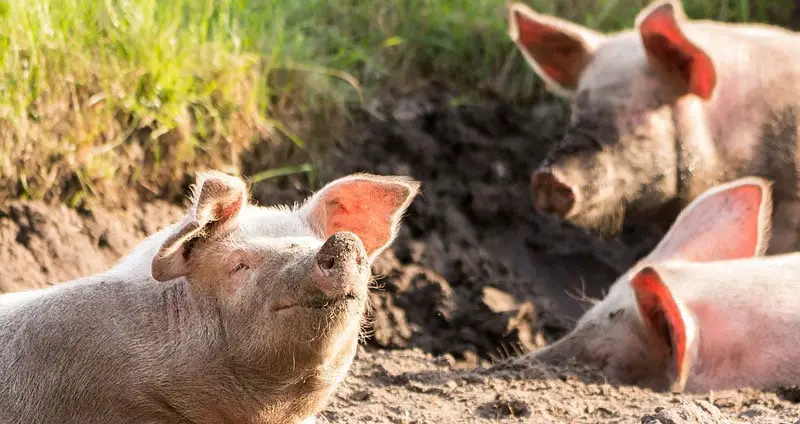While there are a lot of factors that determine a pig’s weight, you can expect most pigs to weigh between 275 and 300 pounds, with the market average typically fluctuating around 285 pounds.
However, the weight highlighted above is the weight in which pigs are most commonly slaughtered. Different breeds of pig that are allowed to grow to their full potential typically weigh between 550 and 750 pounds.
11 Examples Of Adult Pig Weights
|
Pig Breed |
Avg. Weight of Boars |
Avg. Weight of Sows |
|---|---|---|
| Miniature Pig | 130 pounds (59 kg) | 130 pounds (59 kg) |
| Meishan Pig | 132 pounds (60 kg) | 132 pounds (60 kg) |
| Mangalica Pig | 160 pounds (73 kg) | 150 pounds (68 kg) |
| Kunekune Pig | 285 pounds (130 kg) | 285 pounds (130 kg) |
| Danish Landrace Pig | 530 pounds (240 kg) | 600 pounds (272 kg) |
| Tamworth Pig | 550 pounds (250 kg) | 685 pounds (311 kg) |
| Berkshire Pig | 575 pounds (261 kg) | 600 pounds (272 kg) |
| Duroc Pig | 630 pounds (286 kg) | 550 pounds (250 kg) |
| Hampshire Pig | 660 pounds (300 kg) | 550 pounds (250 kg) |
| Large Black Pig | 750 pounds (340 kg) | 650 pounds (295 kg) |
| Large White Pig | 800 pounds (363 kg) | 680 pounds (281 kg) |
What Contributes To A Pig’s Weight?
Simply stating an average weight for a pig is a good baseline, but it’s not a very cut-and-dry metric that’s universally applicable. There are a few different factors that play into the weight of a pig. It’s important to consider all of these factors when planning for how heavy your pig will grow to be.
- Breed – The breed of the pig is the most prominent contributing factor to their weight. Different breeds can vary greatly in size, and this will largely determine how much they end up weighing. Different breeds will also store varying amounts of fat. For example, Hampshire Pigs tend to be more lean, while Meishan Pigs have excess amounts of fat and skin that make them heavy for their size. Domestic pigs are typically bred to grow much larger and heavier.
- Age – Of course, as pigs age, they grow in size. Younger piglets will weigh substantially less than an adult. At birth, the average piglet weighs just over 3 pounds. In just a few short years, though, they can gain hundreds of pounds in some cases. Therefore, if you have a young pig, expect it to gain a good amount of weight as it grows to its full size.
- Feeding – Like any living creature, pigs will weigh more if they’re provided with more food. A consistent supply of a diverse food consisting of grains and good protein sources will help a pig gain a good amount of weight in a healthy manner. Domestic pigs that are kept as pets don’t need to be fattened up as quickly as feeder pigs, so they’ll tend to gain the weight more slowly.
How To Weigh Your Pig
If you aren’t a commercial pig farmer, there’s a slim chance that you’ll own a livestock scale that can be used to weigh your pigs. While this is certainly the easiest way to weigh a pig, it’s not the only way. If you’re able to handle your pig and take a few simple measurements, you’ll be able to make a surprisingly accurate calculation of your pig’s weight.
- 1Acquire a nicely-sized fabric measuring tape. If that isn’t possible, you can make the measurement with a string that’s then laid against a standard measuring tape.
- 2Place the string under the pig, just behind its front legs, and measure the distance around the pig from there. This is known as the heart girth.
- 3Measure the length of the pig along its back from the base of its ears to the base of its tail.
- 4Use the formula to calculate the pig’s weight: ((Heart Girth)^2 * Length) / 400
For example, a pig’s weight with a heart girth of 60″ and a length of 50″ can be calculated by:
60 * 60 = 3600 (heart girth * heart girth = girth result)
3600 * 50 = 180000 (girth result * length = total measurement)
180000 / 400 = 450 pounds (total measurement / 400)

